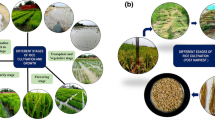Abstract
The present investigation was conducted with twenty-four genotypes (sub-plot) in two phosphorus doses (main plot) in a split-plot design with three replications during the Sali season (July-December) of 2017 at ICR farm, AAU. The ANOVA for 15 characters studied revealed significant variation between the phosphorus doses (0 and 20 kg P2O5 ha−1) for days to heading and 50% flowering, root length and root volume per hill. A highly significant variation among the genotypes was observed for all the 15 characters. The genotype and phosphorus interaction effects were significant for panicle length, filled grains/panicle, chaffs/panicle, spikelet fertility, 1000-grain weights, root length, root dry weight and root volume. A significant advance in days to heading and 50% flowering along with an enhancement in root length and volume was registered for 20 kg P2O5 ha−1. Among the 24 genotypes, only 7 genotypes, namely Herapoa, Gondhi Biroin, Pankaj, Prabhat Sali, Gheu Bora, Betguti-2 and Tulsi Bora, were categorized as high performing on the basis of total scores worked out of all the characters. Among the 3 diverse variety groups, glutinous genotypes contained the highest number of high yielding and phosphorus efficient genotypes followed by normal Sali, while the aromatic rice had only intermediate types. The genotype Herapoa proved to be highly phosphorus efficient based on mean grain yield and grain yield efficiency index (GYEI). This study proved the presence of P-efficient genotypes among the rice landraces of Assam to be used in breeding for low input or organic farming.

Similar content being viewed by others
References
Bationo A, Kumar KA (2002) Phosphorus use efficiency as related to sources of P fertilizers, rainfall, soil, crop management, and genotypes in the West African semi-arid tropics. In: Adu-Gyamfi JJ (ed) Food security in nutrient-stressed environments: exploiting plants’ genetic capabilities. Springer, Netherlands, Dordrecht, pp 145–154
Batjes NH (1997) A world dataset of derived soil properties by FAO–UNESCO soil unit for global modeling. Soil Use Manag 13(1):9–16
De Dutta SK, Biswas TK, Charoenchamratcheep C (1990) Phosphorus requirements and management for lowland rice. In: Phosphorus requirements for sustainable agriculture in Asia and Ocenia (IRRI), pp 307–323
Fageria NK, Morais OP, Baligar VC, Wright RJ (1988) Response of rice cultivars to phosphorus supply on an Oxisol. Fertil Response 16:195–206
Fageria NK, Melo LC, Carvalho MCS (2015) Influence of nitrogen on growth, yield, and yield components and nitrogen uptake and use efficiency in dry bean genotypes. Commun Soil Sci Plant Anal 46:2395–2410. https://doi.org/10.1080/00103624.2015.1081696
Fageria NK, Wright RJ, Baligar VC (1988) Rice cultivar evaluation for phosphorus use efficiency. Plant Soil 111:105–109
Graham RD (1984) Breeding for nutritional characteristics in cereals. Adv Plant Nutrit 1:57–102
Ismail AM, Heuer S, Thomson MJ, Wissuwa M (2007) Genetic and genomic approaches to develop rice germplasm for problem soils. Plant Mol Biol 65(4):547–570
Jackson ML (1973) Soil chemical analysis. Prentice Hall of India Pvt. Ltd., New Delhi
Jakkeral S, Kajjdoni ST, Koti RV (2008) Genotypic variation for root traits to phosphorus deficiency in blackgram (Vigna munga L.hepper). Karnataka J Agri Sci 22:946–950
Kusutani A, Tovata M, Asanuma K, Cui J (2000) Studies on the varietal differences of harvest index and morphological characterstics of rice. Japanese J Crop Sci 69:359–364
Raghothama KG (1999) Phosphate acquisition. Annu Rev Plant Physiol Plant Mol Biol 50:665–693
Sahrawat KL, Jones MP, Diatta S (1995) Response of upland rice to phosphorus in an ultisol in the humid forest zone of West Africa. Fertilizer Res 41:11–17
Sathiyavani E, Prabaharan NK, Surendar KK (2017) Role of mineral nutrition on root growth of crop plants. Int J Curr Microbiol App Sci 6(4):2810–2837
Slaton NA, Wilson CE, Norman RJ, Ntamatungiro S, Frizzel DL (2002) Rice response to phosphorus fertilizer application rate and timing on alkaline soils in Arkansas. Agron J 94(6):1393–1399
Swain RK, Padhiary AK, Behera S, Mishra SP, Jena M, Swain SC, Rout SK (2017) Morpho physiological traits of some rice varieties in response to shallow water depth. Int J Curr Microbiol App Sci 6(11):3950–3957
Theodorou ME, Plaxton WC (1993) Metabolic adaptations of plant respiration to nutritional phosphate deprivation. Plant Physiol 101:339–344
Tian Z, Li J, He X, Jia X, Yang F, Wang Z (2017) Grain yield, dry weight and phosphorus accumulation and translocation in two rice (Oryza sativa L.) varieties as affected by salt-alkali and phosphorus. Sustainability 9(8):1461
Vance CP, And U-S, Allan DL (2003) Phosphorus acquisition and use: critical adaptations by plants for securing a non-renewable resource. New Phytol 157:423–447
Vose PB (1990) Screening techniques for plant nutrient efficiency: philosophy and methods. Gene Aspects Plant Mineral Nutrit 42:283–289
Wang H, Inukai Y, Yamauchi A (2006) Root development and nutrient uptake. Crit Rev Plant Sci 25(3):279–301. https://doi.org/10.1080/07352680600709917
Wang K, Cui K, Liu G, **e W, Yu H, Pan J, Huang J, Nie L, Shah F, Peng S (2014) Identification of quantitative trait loci for phosphorus use efficiency traits in rice using a high density SNP map. BMC Genet 15(1):155
Yoseftabar S (2013) Effect of nitrogen and phosphorus fertilizer on spikelet structure and yield in rice (Oryza sativa L.). Int J Agri Crop Sci 5(11):1204–1208
Zhou S, Wang Y, Li W, Zhao Z, Ren Y, Wang Y, Gu S, Lin Q, Wang D, Jiang L, Su N, Zhang X, Lin L, Cheng Z, Lei C, Wang J, Guo X, Wu F, Ikehasi H, Wang H, Wan J (2011) Pollen semi-sterility1 encodes a kinesin-1–Like protein important for male meiosis, anther dehiscence, and fertility in rice. Plant Cell 23:111–129
Author information
Authors and Affiliations
Corresponding author
Additional information
Publisher's Note
Springer Nature remains neutral with regard to jurisdictional claims in published maps and institutional affiliations.
Electronic supplementary material
Below is the link to the electronic supplementary material.
Appendix
Rights and permissions
About this article
Cite this article
Das, P., Bordoloi, D. & Sarma, D. Variation in Morpho-Agronomic Traits of Lowland Rice (Oryza Sativa) Genotypes of Assam in Response to Phosphorus Fertilization. Agric Res 11, 445–453 (2022). https://doi.org/10.1007/s40003-021-00574-8
Received:
Accepted:
Published:
Issue Date:
DOI: https://doi.org/10.1007/s40003-021-00574-8




